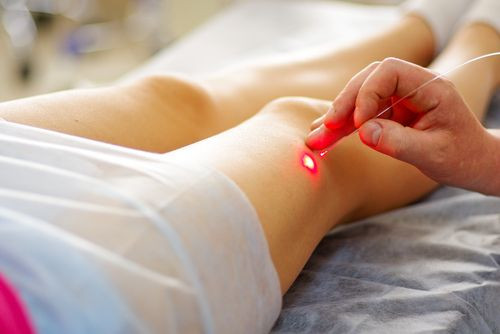Varicose Vein Surgery, Foam, And Laser Treatments Compared; Results Are The Same But Not All Patients Are Happy

Varicose veins are painful and unsightly, making it a high priority for people with them to seek out treatments, except researchers are now finding not everyone is equally happy with their results six months later. The results of all three treatments are the same at first, but over time something begins to change and hinder one set of patients’ happiness levels.
Researchers examined 798 patients who had undergone treatment for their varicose veins at 11 different centers in the United Kingdom and published their findings in The New England Journal of Medicine. Six months after the procedure, they asked the participants how their quality of life was since undergoing foam, laser, or surgical treatment for their varicose vein condition. Patients who received the foam injections gave the lowest ratings out of the three treatments, even though the results are virtually equal.
Varicose veins develop when the body’s veins stop working properly by becoming clogged with blood. By the time people reach the age of retirement, one out of every three people develop varicose veins, and although they don’t present themselves as a serious health problem, in severe cases they can cause constant aching, irritation, swelling, and leg ulcers. The veins you can see through your skin are called reticular veins and are superficial, but when they become swollen and clogged, it’s an indication that two other vein systems may also be suffering. The deep veins buried beneath skin and muscle can only be seen during surgery, and the perforator veins connect the deep and superficial together, which is why it’s important to make sure they don’t reach deeper levels.
Sclerotherapy is the most common treatment approach and involves a chemical solution, which is injected into the veins and causes them to collapse and form scar tissue to permanently close them. It’s not dangerous to your health because nearby veins take up the re-routed blood flow seamlessly and patients typically report an 80 to 90 percent improvement with gradual fading over time, according to New York Cosmetic, Skin & Laser Surgery. Ultrasound-guided foam sclerotherapy is an alternative to surgically removing varicose veins, but even without having to go under the knife, patients who received the foam injections gave slightly lower ratings on their quality of life compared to surgery or laser therapy.
Typical surgery is only needed for patients when they have particularly larger veins, which are often caused because of obesity, lack of exercise, or multiple pregnancies. The heart pumps blood throughout the body from the head to the toes, and when the blood flows down the legs, the veins may be blocked because the oxygen can’t be transported through properly as a result of poor diet. Exercise, of course, engages the muscles, pumps the blood, and moves oxygen swiftly in and out of the lungs and through the body, so without adequate movement, the veins become coagulated and suffer from clogging.
Researchers found in their study that laser therapy was the least likely to cause minor complications such as bleeding or bruising, which may be why those who underwent laser surgery reported they were happier than those with the foam treatments. But what’s wrong with the foam treatments if they yield the same results?
"Basically, this is a well-designed study that shows these treatments are similarly effective and safe," Dr. Peter Gloviczki, a vascular surgeon at the Mayo Clinic in Rochester, Minn. Gloviczki who was not involved in the study, told HealthDay. "But foam is less invasive than ablation and it's usually less expensive. Patients should be aware that if I use foam, there is a good chance I'll have to treat you again in the next few years.”
Another foaming drawback was patients who needed treatment for saphenous veins, the ones that run down the length of the leg, had a 55 percent patient success rate. It’s no surprise because 45 percent of those who received the injections still had these long vertical veins running down for all to see and pain to still bear. Meanwhile 80 percent of patients who had surgery or laser therapy found successful treatment for these veins.
Source: Brittenden J, Gloviczki P, Cotton SC, Elders A, Ramsay CR, and Norrie J, et al. A Randomized Trial Comparing Treatments for Varicose Veins. New England Journal of Medicine. 2014.
Published by Medicaldaily.com



























